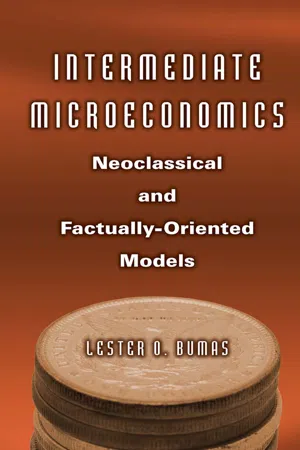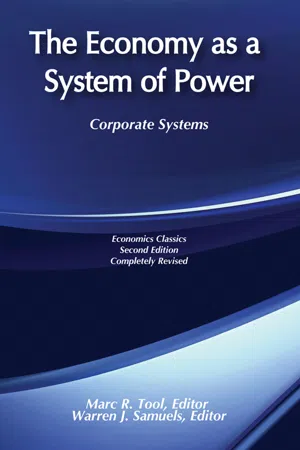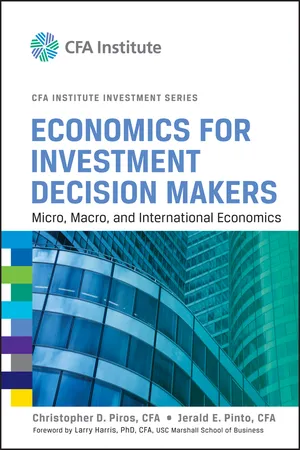Economics
Oligopolistic Market
An oligopolistic market is characterized by a small number of large firms dominating the industry, leading to intense competition and interdependence among the firms. These firms have the power to influence prices and market conditions, often resulting in strategic behavior such as price leadership or collusion. Oligopolies can lead to reduced consumer choice and potential for anti-competitive practices.
Written by Perlego with AI-assistance
Related key terms
10 Key excerpts on "Oligopolistic Market"
- eBook - ePub
Microeconomic Principles and Problems
A Pluralist Introduction
- Geoffrey Schneider(Author)
- 2024(Publication Date)
- Routledge(Publisher)
a market that is dominated by a few huge firms whose behavior affects each other significantly. There are large barriers to entry that keep out new competitors. In general, markets become oligopolistic when there are significant benefits to being huge. For example, in the manufacturing of cars, cell phones, steel, and other products, producing on a massive scale results in much lower costs of production. Firms can develop specialized plants utilizing very specialized equipment and labor to produce each component and additional specialized factories to assemble the components. That degree of specialization reduces costs and increases productivity significantly. Similarly, national retail chains like Walmart, Amazon, and Costco have vast networks of warehouses that allow these firms to supply goods cheaply to any corner of the country. Even more important, their huge size gives them the power to demand lower prices from their suppliers, allowing national retailers to sell goods at lower prices and thereby undercut smaller competitors. In addition, their financial resources allow huge firms in Oligopolistic Markets to buy out competitors and to cultivate political favors by making campaign contributions and hiring lobbyists. This allows oligopolists to continue to dominate markets, even if they are not particularly efficient. Competition to stay ahead often takes on a complex form in oligopolies (colluding, merging, advertising, lobbying), rather than the price competition we find in competitive markets.The major characteristics of an oligopoly are as follows:- Products may be differentiated or undifferentiated: Oligopolistic industries that manufacture goods for consumers (cars, cell phones, etc.) sell differentiated products. Oligopolistic industries that manufacture materials used in the production of other goods, such as inputs like steel or aluminum, tend to produce undifferentiated products.
- Dominated by a few huge firms:
- eBook - ePub
Intermediate Microeconomics
Neoclassical and Factually-oriented Models
- Lester O. Bumas(Author)
- 2015(Publication Date)
- Routledge(Publisher)
Consider more deeply the boundaries of a market. There may be hundreds and sometimes thousands of retail stores selling the same product in a metropolitan region such as New York City. But much shopping takes place in a given neighborhood in which there are only a small number of stores for various kinds of common products: a few groceries, a couple of bakeries, three green grocers, a few banks, a couple of hardware stores, two gas stations, two auto repair shops, and several restaurants with only one or two of a particular culinary type. Each knows the existence of rivals selling close substitutes and, I suspect, pays some attention to their activities. These very small firms are also quasi-oligopolies.By the way, Adam Smith was well aware of the significance of the size of the market. His chapter “That the Division of Labour is Limited by the Size of the Market” indicates this. In a small market, he asserted, the country carpenter “is not only a carpenter, but a joiner, a cabinet maker, and even a carver in wood, as well as a wheelwright, a ploughwright, a cart and waggon maker” (1937, [1776], p. 17).Summary on Oligopoly
Oligopolies are large firms which dominate an industry and are rival conscious. Some of our most important industries are dominated by oligopolies. Cournot’s duopoly model is the oldest of those attempting to indicate the effect of a rival on the decision-making of a firm. Sweezy’s kinked demand function, based upon the assumed reactions of rivals, helps to explain the tendency of oligopoly prices to be sticky—to respond slowly to changes in supply and demand. Game theoretic models attempt to add to our understanding of the strategic actions made in the context of expected responses and sometimes independent actions of rivals.Concentration ratios are a measure of the extent of monopolization in a market. The traditional four largest firm measure has many imperfections, some of which are resolved by the Herfindahl-Hirschman concentration index.Price leadership frequently evolves in lieu of price competition. Non-price competition is the norm in stable oligopolies. Their advantage is that some forms of non-price competition are difficult to emulate, some can be hidden from view, and none are as threatening as price competition.Oligopolistic Markets have barriers to entry. These arise from the economies of large-scale production, large financial start-up requirements, the need for special hard-to-get resources, and the requirement of special know-how. Technological advances have mixed effects on the development of this market form. Discoveries of value can, on the one hand, lead in the direction of monopolization and, on the other hand, allow for easier entry and an increase in competition. - eBook - ePub
The Economy as a System of Power
Corporate Systems
- George Sternlieb(Author)
- 2017(Publication Date)
- Routledge(Publisher)
15 Oligopolistic Cooperation: Conceptual and Empirical Evidence of Market Structure EvolutionJohn R. Munkirs and James I. SturgeonIn this article we introduce the concept of oligopolistic cooperation based on structural intradependence, and propose it as a more accurate description of the industries that comprise the industrial core of the U.S. economy. Many economists agree that oligopoly is the most prevalent market structure in the United States and other industrialized countries.1 This is especially true in finance, mining, and manufacturing. Even though the chief characteristics of oligopoly are “few” firms and psychological interdependence among these firms, it is usual to characterize their behavior as competitive, although not always via price. This characterization of their behavior suggests the name “oligopolistic competition.”Here we distinguish between oligopolistic competition and what we call oligopolistic cooperation.2 Specifically, cooperation is intended to signify behavior that goes beyond coordination or “unconscious parallelism.” And, while cooperation is similar to coordination in some respects, there are fundamental differences. The primary difference is that in oligopolistically cooperative industries specific, legally binding, quasi-permanent organizational structures exist. In turn this type of organizational structure provides not only the means but the necessity for cooperative behavior. Cooperative behavior, in turn, has profound implications for the relevance of micro and macro economic theory as well as public policy.Oligopolistic Competition: The Standard ViewLeading oligopoly theorists such as Fritz Machlup and E. H. Chamber-lain have argued that as a result of mutual interdependence the basic problem facing oligopolists involves the reaction of competitors to each others' price, quality, production, and capacity decisions. Fewness creates a psychological awareness and intense rivalry absent in other market structures. More than thirty years ago Machlup made the point as follows: - eBook - ePub
The Microeconomics of Wellbeing and Sustainability
Recasting the Economic Process
- Leonardo Becchetti, Luigino Bruni, Stefano Zamagni(Authors)
- 2019(Publication Date)
- Academic Press(Publisher)
This criticism suffers from a weakness, which Chamberlin himself pointed out: it overlooks the fact that differentiation is linked to consumer preferences, who are often willing to pay a higher price in order to have the possibility of choosing from among different varieties of the same type of good. This is as if to say that product diversity comes at a price. Said another way, the possibility of actually being able to make a choice is a positive argument in consumers' utility functions, who show that they increasingly appreciate its value. Regarding the comparison with a monopoly, note that over the long run extra profits are zero in both perfect and monopolistic competition. A monopoly enterprise, however, can earn extra profits even over the long run as long as it is able to maintain the entry barriers it set up for its protection. Finally, we observe that resources are inefficiently allocated in both a monopoly and in monopolistic competition.6.5. An Oligopolistic Market
6.5.1. Its distinctive characteristics
An oligopoly is a market structure in which several companies operate, but none of them have a negligible market share (as happens in perfect competition). Every oligopolistic enterprise is thus able to exercise a certain influence on the relevant price and/or quantity variables and is aware that other companies operating in the sector can, by their decisions, do the same. The distinctive nature of an oligopolistic structure is that there is strategic interaction between companies; such interaction is absent in a monopoly and in perfect competition, in which companies, taking price as a given, behave atomistically.Consider a duopoly, or a market in which there are only two suppliers and multiple buyers. In addition to company A , another company B produces and sells an identical product as its rival. Suppose the two companies know the behavior of the good's consumers, summarized by the demand function p=f (q ); p indicates the price and q indicates the total output, which is equal to the sum of qAand qB, representing the production levels of the two companies A and B respectively. For the sake of simplicity, assume that production costs are zero. If each company independently chooses its output level to maximize its profits (indicated by π ), then firm A chooses qAto maximize πA=pqA=f (qA+qB)qA. As we see, πAalso depends on qB; that is, A 's optimal output level choice is no longer independent of the output level simultaneously chosen by the other company, as it is in perfect competition. Thus there is no demand curve for an individual company in an oligopoly; the quantity of product an oligopolist can sell at a certain price depends on what its rivals do. This is why an oligopolist can never know with certainty - eBook - ePub
Economic Principles and Problems
A Pluralist Introduction
- Geoffrey Schneider(Author)
- 2021(Publication Date)
- Routledge(Publisher)
Dominated by a few huge firms: A handful of giant firms control most of the industry. There may be some smaller firms but the major dynamics of the market revolve around the interplay between the dominant firms.- Significant barriers to entry: In manufacturing, economies of scale are so significant that only huge firms with access to the latest technology and a global supply chain can compete. In consumer goods, brand name recognition and first mover advantages (where consumers get comfortable with a particular product, such as Facebook or the iPhone) allow certain companies to dominate. It is extremely difficult for new firms to enter such markets.
- Interdependence among firms: When a handful of firms dominate an industry, the actions of one of the big players have a large and direct impact on the other firms. Firms watch each other very closely and try to match price cuts and counter advertising campaigns. This also leads to incentives for firms to collude to act like a monopoly or to merge in order to lessen competition. Most instances of collusion occur in oligopolies.
Strategic considerations in Oligopolistic Markets are multiple and complex. The importance of size and technology means that firms must invest substantially in research and development. The importance of brand name recognition means that there is substantial non-price competition, usually in the form of vast advertising and marketing campaigns. Collusion and mergers and acquisitions are also ways to reduce competition and enhance profits. And oligopolistic firms can secure their position in a market via hiring lobbyists and making donations to campaigns and political action committees to get reductions in taxes and regulations that inhibit their profits. An interesting example of the type of competition we see in an oligopoly is the cola wars and the efforts by Coca-Cola to preserve its market share. - eBook - ePub
Microeconomics
A Global Text
- Judy Whitehead(Author)
- 2014(Publication Date)
- Routledge(Publisher)
In this chapter, several of the classical or traditional models and the standard models of oligopoly, including the Game Theory are examined. The more recent developments in the theory of the firm pertaining mainly to the market structure of oligopoly are left to the next chapter.12.1 Assumptions, Definitions and Summary of Models
12.1.1 Assumptions
There are a number of assumptions that are common to all models of oligopoly. These are:- The industry consists of a small number of firms. This is understood to be fewer than under the market structure of Monopolistic Competition.
- The goal of the firm is to maximize profit.
- All factors are freely available to the firm at given prices.
- There is a great deal of interdependence (actual and/or perceived).
- The products in the industry may be homogeneous or differentiated.
Reasons for oligopoly
Typically, oligopoly exists because of:- Economies of scale in production.
- Economies of scale in advertising or promotion of the product.
- Limited access to raw materials.
- Government controls on access to the market (e.g. permit requirements, etc.).
- Capital barriers to entry.
- Branding and preference barriers or other barriers to entry.
12.1.2 Definitions
Classical or traditional oligopoly
The term classical oligopoly is used to distinguish the traditional models from the modern or alternative models of the firm introduced since the 1950s. The non-collusive and collusive models listed above are all part of classical or traditional oligopoly.Pure and differentiated oligopoly
Under pure oligopoly firms produce a homogenous product (e.g. flour, salt). Under differentiated oligopoly firms produce a differentiated product (e.g. automobiles, refrigerators). These products are usually differentiated by branding. As with Monopolistic Competition, the differences may be real or fancied. However, they must be such that the consumer perceives the products to be different.12.1.3 Model summary
The various traditional or classical models of oligopoly may be grouped into the two major classes of non-collusive and collusive. The game theory approach to modelling oligopoly in terms of competitors in a game with strategies and counter-strategies may be included among the traditional models. The models may be summarized as follows. - eBook - ePub
- J. Bridge, J. C. Dodds(Authors)
- 2018(Publication Date)
- Routledge(Publisher)
Table 6.2 . Further examination of the Census data reveals that if the rate of growth in concentration experienced during the 1958-68 period is maintained, something of the order of two thirds of products will have concentration ratios (based on net output) of between 80 and 100 per cent by 1993. Thus as overall concentration, industry concentration and concentration in specific product markets is increasing, a study of big business behaviour is vital to economists and students of management alike. The rest of this chapter examines models of oligopoly behaviour and discusses some of the attempts to control oligopoly and monopoly through public policy.Oligopoly relates to fewness of sellers (duopoly where there are only two) and it can take the pure form (where there is an homogeneous product) or the more usual imperfect form where there is product differentiation. The distinguishing feature of oligopoly is not just the number of sellers but rather the mutual interdependence felt by oligopolistic firms in their decision making. We illustrated above how firms under conditions of perfect competition were price takers and free to pursue their output policy without recourse to considering the activities of other firms operating in the same market. An absolute monopolist with complete control of a product and its close substitutes, is also free to pursue an independent line of policy. When we come to oligopoly, however, a firm must have regard to the activities of other firms in the industry who are supplying for the same market. This is not to say that at all decision levels this will be the case but certainly for many strategic decisions governing the future course of the firm – such as the launching of new products and the associated advertising and promotional expenditures firms should take account of the anticipated reactions of rivals. Pricing decisions, although frequently classified as operating decisions* may also give rise to interdependence. In fact there may be a complex interplay of anticipated strategies and counter-strategies which firms engage in, a topic which is examined later in this section in terms of the theory of games. Firms can either ignore interdependence - particularly for operating decisions (as we illustrate later in the Baumol sales revenue maximisation model) or make some specific evaluation as to how rivals will react to a given policy change; this evaluation is sometimes called the ‘conjectural variation’. Alternatively they may try to reduce the uncertainty of interdependence by collusion (see G. Stigler [142 - eBook - ePub
- Amal Sanyal(Author)
- 2017(Publication Date)
- Routledge(Publisher)
It is a market for a relatively homogeneous product with a small number of sellers. So, each seller can influence price to an extent by selling more or selling less. Oligopolies selling the same product share a given market demand. This is what makes oligopoly different from monopolistic competition. In the latter, each seller has a separate demand for its niche product. However, price charged by one oligopoly or how much it sells affects other oligopolies in the same market. An action by one leads others to change their price or sales decisions, and in turn this might lead the first firm to change its action too. Hence an oligopoly decides about its moves, much like in a game of chess, by thinking of the likely effects of its action on competitors. For this reason oligopoly decisions are called ‘strategic’. An oligopoly cares not only about demand and cost, but also about competitors’ moves. The analysis of how an oligopoly business goes on, how decisions are made and battles fought is interesting and intriguing. The strategic aspect of their behaviour is analysed by using Game Theory, a branch of mathematics that analyses interactive decision making. The first analysis of oligopoly appeared quite early. In 1838 a French mathematician and engineer named Augustin Cournot (1801–1877) produced an analysis 3 that is still part of the economics curriculum. Around this time, scholars with mathematics, engineering, and science backgrounds were taking interest in economic issues and formalising them with mathematical reasoning. Cournot analysed a scenario where only two firms shared a market and were trying to decide their best quantity of sale. The two were competing to get the most profit at the expense of the other. The market with two sellers is called a duopoly and is a convenient starting point for understanding oligopoly. Cournot worked out the eventual equilibrium of the market, that is, who sells how much and the price at which the market would settle - eBook - ePub
Economics for Investment Decision Makers
Micro, Macro, and International Economics
- Christopher D. Piros, Jerald E. Pinto(Authors)
- 2013(Publication Date)
- Wiley(Publisher)
When is an oligopoly not an oligopoly? There are two extreme cases of this situation. A normal oligopoly has a few firms producing a differentiated good, and this differentiation gives them pricing power.At one end of the spectrum, we have the oligopoly with a credible threat of entry. In practice, if the oligopolists are producing a good or service that can be easily replicated, has limited economies of scale, and is not protected by brand recognition or patents, they will not be able to charge high prices. The easier it is for a new supplier to enter the market, the lower the margins. In practice, this oligopoly will behave very much like a perfectly competitive market.At the opposite end of the spectrum, we have the case of the cartel. Here, the oligopolists collude and act as if they were a single firm. In practice, a very effective cartel enacts a cooperative strategy. As shown in Section 5.1, instead of going to a Nash equilibrium, the cartel participants go to the more lucrative (for them) cooperative equilibrium.A cartel may be explicit (that is, based on a contract) or implicit (based on signals). An example of signals in a duopoly would be that one of the firms reduces its prices and the other does not. Because the firm not cutting prices refuses to start a price war, the firm that cut prices may interpret this signal as a suggestion to raise prices to a higher level than before, so that profits may increase for both.6.1 MONOPOLY
Monopoly market structure is at the opposite end of the spectrum from perfect competition. For various reasons, there are significant barriers to entry such that a single firm produces a highly specialized product and faces no threat of competition. There are no good substitutes for the product in the relevant market, and the market demand function is the same as the individual firm’s demand schedule. The distinguishing characteristics of monopoly are that a single firm represents the market and significant barriers to entry exist . Exhibit 4-1 identified the five characteristics of monopoly markets:1. There is a single seller of a highly differentiated product. - eBook - ePub
Experimental Economics
Volume II: Economic Applications
- Pablo Branas-Garza, Antonio Cabrales, Pablo Branas-Garza, Antonio Cabrales(Authors)
- 2016(Publication Date)
- Palgrave Macmillan(Publisher)
2 Non-Competitive Markets Nikolaos Georgantzís and Giuseppe Attanasi IntroductionA market is not competitive when the agents acting in such a market have the power to influence the price, directly or indirectly, something that does not occur under perfect competition. Generally, these agents have market power because they are few in number, have access to relevant information and can foresee the interdependence between their strategies and those of others.Among all the paradigms in economic theory, the theoretical predictions of oligopoly were the first to be examined in the laboratory. In the origins of experimental economics one can find the works of Chamberlin (1948) and of Smith (1962, 1964), who designed experiments to study a market with few agents that could reach the competitive equilibrium (see Chapters 1).In this chapter, instead of surveying all experiments with few sellers,1 we will adopt a narrower definition of the term “oligopoly ,” and will focus on experiments that were directly inspired by the basic oligopolistic models of Cournot (1838), Bertrand (1883), Hotelling (1929), von Stackelberg (1934), and similar. We will omit, therefore, other experiments, such as those of Chamberlin and Smith, which were designed with the aim of testing the predictive power of the competitive equilibrium model.Most of the experiments we consider in this chapter have been run in the last three decades.2 This literature can be considered as a new wave of experimental work, aiming at representing basic Oligopolistic Markets and testing their properties. This work represents a systematic attempt to study a similar, but not identical, question to that tackled by Chamberlin (1948) and Smith (1962, 1964). While the latter compared the results in the laboratory with predictions of the competitive equilibrium , the series of experiments we review here compare observed behavior with the corresponding oligopolistic equilibria
Index pages curate the most relevant extracts from our library of academic textbooks. They’ve been created using an in-house natural language model (NLM), each adding context and meaning to key research topics.









